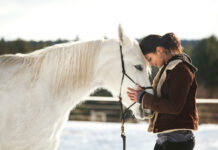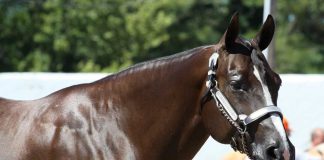Precision and attention to detail are always important in the show pen, but they are especially crucial in showmanship competition. Horses must be turned out to perfection, and handlers need to be able to keep one eye on the horse and the other on the judge to ensure a flawless performance. With such high standards, how can you rise above the competition?

First Impressions
Much of your success in showmanship comes from what you do before you even set foot in the show pen. According to the American Quarter Horse Association (AQHA) rulebook, the object of the division is to “evaluate the exhibitor’s ability to execute, in concert with a well-groomed and conditioned horse, a set of maneuvers prescribed by the judge with precision and smoothness.” While your horse’s conformation is not being judged, he needs to have the healthy glow that comes from proper nutrition, sufficient exercise and regular, thorough grooming.
Creating a good first impression when you enter the ring is imperative. A poorly fitting halter, inappropriate attire or sloppy grooming will put negative marks on your scorecard before you’ve even had a chance to present your horse or execute your pattern.
Marianne Bartley-Lehman, AQHA Professional Horseman, judge, and director of riding at Midway College, emphasizes the importance of proper tack and attire in showmanship competition.
“A show halter should always be clean leather and must be well-fitted,” says Bartley-Lehman. “This is much more important than lots of silver or bling. The noseband should be snug but not cutting off circulation, and should sit no more than one to two fingers below the point of the cheek.”
A fancy halter isn’t essential, but you can improve your horse’s look by finding one that complements his appearance. “The width of the leather should flatter the conformation of the head,” says Bartley-Lehman. “Use narrow leather for fine heads and wide leather for large or coarse heads.”
Traditionally, showmanship exhibitors have used a lead line with a chain, but this is not always necessary. “Use what works best for your horse and helps him be responsive to your cues,” says Bartley-Lehman. “If you don’t use a chain, attach the [lead line] snap to the center ring of the halter behind the horse’s chin.”
If you do use a chain, there are two acceptable ways to run it through the halter. If your horse is a bit lazy, run the chain through the lower ring on the near side of the halter, then under your horse’s chin, through the lower ring on the off side and up the cheekpiece, clipping it to the top ring on the off side. For a more sensitive horse, also run the chain through the center ring underneath the horse’s jaw to lessen the pressure. In either case, always be sure to clip the chain with the snap facing away from the horse’s cheek so that it isn’t poking him. This also eliminates the risk of the snap opening if his jaw rubs against it.
Once the chain is through the halter, there should only be 4 to 6 inches of chain left from the halter to the leather part of the lead. This will allow you to hold the lead correctly without having your hand on the chain. “If a chain is too long, you can have links removed at a hardware store,” suggests Bartley-Lehman. “A temporary fix is to double the snap over and clip it back to the chain.”

If you use a chain, run it under the horse’s jaw and up the cheekpiece, clipping it to the top ring with the snap facing out (left photo). If your chain is too long, a quick solution is to double the clip back on the chain (center). Photos: Leslie Potter
Dress for Success
When selecting your show attire, cleanliness and proper fit will always trump trendiness.
“Ideally, we like to see exhibitors wear formal showmanship pants, but starched, dark-colored, well-fitting jeans—especially for male exhibitors—are acceptable,” says Bartley-Lehman. Whichever type of pants you wear, they should be long enough to reach the ground. Keep them rolled up until just before you enter the show pen so that they stay clean.
“Well-fitting shirts or tunic tops will work, but short jackets or blazers are better,” adds Bartley-Lehman. “Stay away from trendy, loud clothing. Choose clothing with longevity and keep your boots clean and simple. The most important part of your outfit is your hat. Make sure it is shaped correctly, is clean, and complements your face.”
Bartley-Lehman says that gloves are not typically worn by AQHA and other stock-breed exhibitors, but showmanship exhibitors on Arabian and other breed circuits still frequently wear them.
Presenting Your Horse
When competing in showmanship, exhibitors use the quarter method to properly present their horse to the judge. Imagine that your horse is divided into even quadrants, with one line running from your horse’s nose to his tail and another one running across him from just behind his front legs. As the handler, you should always be at the front of your horse in the quadrant adjacent to the one the judge is currently occupying.
“The main purpose of the quarter method is to allow the judge to have an unobstructed view of the horse at all times,” explains Bartley-Lehman. “It also allows the exhibitor to maintain eye contact with the judge while simultaneously watching the horse.”
As a judge, Bartley-Lehman often sees exhibitors lose points when presenting their horse because they haven’t mastered the quarter method. “Each time the judge crosses into a new quarter, the exhibitor should do the same. Frequently, I’ll see exhibitors who are too slow to move into the new position, or overeagerly move too soon. Another common error is exhibitors who appear mechanical in the way they move from quarter to quarter.”
Practicing at home will help you become comfortable with the system, which will enable you to move naturally and with confidence during competition.
“One exercise I like to use involves laying brightly colored lead ropes on the ground,” says Bartley-Lehman. “I position the lead ropes in a straight line forward in front of the horse’s nose, backward away from the horse’s tail and outward from the horse’s left and right forelegs. Then I have someone play the judge and walk around the horse at various speeds, stopping, starting and changing directions. The exhibitor should practice moving around the horse as the pretend judge walks around the horse until it becomes second nature.”

Performing the Pattern
Remember that while your horse’s performance will factor into your score, the judge is primarily looking at your skills as a handler. The AQHA rulebook states that the handler should “exhibit poise and confidence, and maintain a balanced, functional and fundamentally correct body position.” Your position should be perfect from the moment you enter the show pen until you are dismissed.
Bartley-Lehman suggests exhibitors pay attention to the following details of their position throughout the class to gain an edge.
- Your chin should be up and your shoulders back.
- Keep your elbows bent and at your sides.
- Keep your hands up and even with your horse’s head.
Through practice, you and your horse will become more comfortable during the pattern. While nerves are normal for some exhibitors, don’t let them get the best of you.
“I often see exhibitors lose points because they don’t look up to where they are going,” says Bartley-Lehman. “This causes them to appear lacking in confidence and prevents them from performing the pattern with precision.”
Study the pattern well before you’re called into the show pen, and practice in the warm-up ring so you can perform with poise. “An exhibitor can really stand out from the crowd if she looks up and exudes a cool, pleasant confidence while smoothly performing maneuvers and moving naturally around the horse.”
At the highest levels of competition, exhibitors are expected to complete their patterns with speed and precision, but if you’re just starting out, don’t push the speed at the expense of accuracy. While you don’t want to move so slowly that you appear timid or sluggish, it’s more important to execute the pattern correctly and smoothly, and to perform each maneuver at the designated marker.
It’s in the Details
Although mane banding isn’t required for showmanship, it is standard practice for Quarter Horses and other stock breeds. Plan to band your horse’s mane if you want to do well in your showmanship class. Nothing can undermine an otherwise perfect grooming job like messy bands, and it takes practice to get it right. The bands must be equally sized and lie flat along your horse’s neck. Loose hairs or banded sections pointing in every direction will detract from your look. Allow yourself a few practice runs before show day so that you’ll be able to do it right when it counts.
Just like ridden classes, success in showmanship requires practice, preparation and a solid understanding of what the judge is looking for. Apply these tips, and you and your horse will shine at your next show.
Further Reading
How to Fit a Halter for Showmanship
Perfect Your Showmanship Pattern
Leslie Potter is Managing Editor of horseillustrated.com and holds a Bachelor’s degree from William Woods University in Equestrian Science. Follow her on Twitter: @LeslieInLex
This article originally appeared in the June 2012 issue of Horse Illustrated. Click here to subscribe.






Perfect!